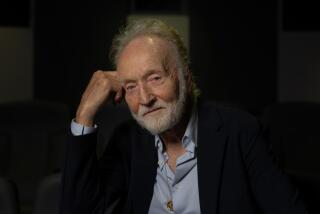A Big Chill Invades Lives as Bill Vanishes
- Share via
Bill was my first great love, an artist whose passions seemed to outshine the sun, a handsome young man whose Southern charm was as irresistible as a force of nature.
From the window of my college Shakespeare class, I’d watch for him to walk back to the fine arts center from lunch. I would spot him a mile away, loping along in his work boots, jeans and tweed jacket, and my heart would pound against my ribs.
It was 1973. I was 19.
By the time he vanished, almost six years ago, I had long known Bill’s passions masked the embryonic stages of madness. His youthful charm was no longer enough coin to purchase patience and sanctuary. He had alienated our circle of friends, along with almost everyone else who ever loved him.
We watched “The Big Chill” with a shiver of anticipation that one day it would be us, clustered in a Southern churchyard to bury our friend. We gathered at weddings, retold the now-threadbare Bill stories, and wondered aloud if he were still alive.
For most of us, that was as far as it went.
But his little sister, whom he adored, kept her phone listed in her maiden name in the hopes that he would one day call. And my heart could not accept the thought that Bill could die and none of us would know, that there would be no tremble in the earth or light in the sky to announce his passing.
So in the spring of 1996, I called the little sister. Carol was 12 the last time I saw her. She was a grown woman now, with a daughter nearly that age. There was no reason for her to remember me, but she spoke freely, seeming relieved that someone wanted to listen.
She alone in Bill’s family had refused to give up hope. I had been convinced that Bill was dead, but Carol’s faith rekindled mine.
There had to be some way to find our charming madman, a tarnished needle in a 3,000-mile-wide haystack. There just had to be.
*
William E. Hipp III grew up in an affluent family in the affluent college town of Davidson, N.C. But his roots seemed to be a few miles away, on the farm worked by his paternal grandfather, the first in the family to bear the name Bill now signed in a bold scrawl. It was on the farm, along a creek, that Bill found a blue-gray clay he could shape and mold. Sculpting in clay would become the center of his life.
We met at the state university in Charlotte. I had never seen anyone like him. I didn’t stand a chance.
Bill seemed to want to consume life. His intellectual curiosity was insatiable, ranging from quantum physics to pre-Columbian art. He was incapable of small gestures, small emotions. A toast called for the smashing of glasses into the fireplace. He would load my arms with wildflowers, or fill every glass in his home with roses for my visits. A large yard meant croquet, complete with white linen and gin and tonics. We walked down dirt roads on starlit nights, brandy glasses in our hands. We sat beside a mountain waterfall sipping wine as the colors of autumn exploded around us. We streaked on a moonlit beach.
It wasn’t long before I knew I was dancing on quicksand. Bill would vanish for days at a time; he didn’t tell, and I didn’t ask. It seemed impossible for me to leave him, no matter how he might try to provoke me into being the one who walked. But some instinct for self-preservation prevailed. I made arrangements to transfer to a college nearly 1,000 miles away.
By the time I left, in the autumn of 1974, Bill was living with a beautiful blond named Paul. His sexuality had always seemed as casual as a change of clothes. It was as though, as an artist, he was somehow required to explore everything.
Through it all, he stayed in touch with me. My heart was always open to him, and he needed the refuge, the simplicity and sanity I could provide.
Five years after our breakup, when my job took me to New York, Bill went with me. He stayed long enough to see that I got to work on time, and long enough to resume our relationship.
Through the mid-’80s, we saw each other whenever we could. He’d come to New York to cast his bronzes at a Long Island foundry; I’d fly south to another college town, Chapel Hill, to sit on the veranda of his country studio, listening to the night frogs in the trees, smelling the perfume of the roses and gardenias he lovingly tended.
There was never enough work, but he was developing an excellent reputation as a portrait sculptor. He won some prize commissions--a bust of Sam Ervin, chairman of the Senate Watergate Committee, and another of Dean Smith, the winningest coach in college basketball, which holds pride of place in the arena bearing Smith’s name.
But the madness continued to encroach. At first, Bill would stay in bed for days, depressed. As he grew older, he tried to stave off decline with periodic visits to mental wards and various medications. Nothing helped for long.
He’d soon stop taking his medication and start drinking. What we had thought was manic depression seemed to deepen into classic paranoid schizophrenia. Bill recognized no boundaries for his behavior; any impulse deserved to be acted on.
Usually, his charm rescued him. But as he drank more and more, that, too, wore thin. Finally, as small humiliations grew into wounds too painful to bear, I called off our affair.
He would still phone me occasionally--to tell me of a short-lived marriage, for example. But when his talk turned to the cure he was developing for AIDS, his grandiose plans for bringing art to the masses, his pursuit by the CIA and the KGB, I turned away. He stopped calling.
I moved from New York, and moved again, and moved again. I was certain Bill would eventually call or show up on my doorstep. But there was nothing. The dread slowly faded; I spent years recovering.
Van and Cindy, who married after college, were the last of our group to see him, about a year before he disappeared. By then parents of three small children, they no longer had room in their lives for this virtual stranger clutching a bottle. Cindy was petrified her children would wake up and find Bill dead in his bed.
Later, we heard a friend had taken him in. Much later, we heard he had been declared indigent and placed in public housing in a town far from his country studio. He was in and out of institutions. He broke into a liquor store, then called police and waited for them to come get him.
In the summer of 1991, he appeared at the home of one of his patrons, flashing $5,000 in cash he said he collected on a debt. The next day, apparently, he headed for New York. He called his grandmother collect from a telephone booth in Manhattan. And then he vanished.
Carol told me of the things she had done to try to find him. Private detectives pinpointed the phone booth’s location, and determined that both his Social Security number and his credit cards were inactive. He apparently had stopped carrying identification long before.
Bill’s little sister drove all over their home state, searching the streets for any sign of him. She consulted psychics for clues.
But when she told me no one had heard from him for years, I knew he was dead. Bill was never one to suffer alone. He would have called for money or help; he would have gotten drunk and nostalgic and contacted an old friend. No, something had happened to him there in Manhattan, a homeless crazy man on the street with a big wad of cash.
I spent four hours sobbing on the phone to my best friend, until finally I choked out the crushing guilt: I had killed Bill by turning him away. Suddenly, I felt almost lighthearted. The strings were cut. I was, unbelievably, free.
But, still, the Bill we had loved didn’t deserve to be buried under a number in Potter’s Field. We had to bring him home.
If he was dead, it seemed clear, our only hope of identifying him lay in photos or fingerprints.
Carol made friends with a woman in the North Carolina missing persons bureau, who got things moving. After the woman came up with a set of Bill’s fingerprints from a youthful drug arrest, we prayed that somewhere, in some computer, lurked a match.
Last summer, while in New York on business, I visited the police missing persons bureau at the medical examiner’s office to view pictures of unclaimed or unidentified bodies from 1991. I knew it would be gruesome, but it was something I could do for Bill, and for his family.
In a way, it would expunge my guilt.
I was handed a wooden box brimming with Polaroids. For two grotesque hours, I looked at faces and what was left of faces--or, in the worst cases, merely an assemblage of severed limbs.
Few of these men were recognizable as human; none was recognizable as Bill.
I was relieved he wasn’t there; I was disappointed I hadn’t found an answer. Most of all, I was sad, not for Bill but for all those poor, unclaimed souls who had once loved or been loved. Saddest were the pictures of the young men ravaged with AIDS who’d gone to Potter’s Field because no one came to take them home.
When I left, knees shaking, craving a drink and a cigarette, I asked an officer for his card.
“We don’t have them here,” he told me. “No one wants to stay that long.”
*
A picture of Bill posing with his bust of Dean Smith is posted on the Charlotte-Mecklenburg Police Department’s missing persons Web site. I have to look closely to find the Bill I knew. His eyes are baggy and red-rimmed; the look in them is wary. He reminds me of an animal caught in a trap.
Since Bill disappeared, his beloved grandparents have died. His father died last summer.
A quarter-century has passed since those heady days when we all met, but Bill once again has pulled together the group of college friends who loved him. We exchange news, tell the old stories and take comfort from each other.
We have survived and prospered. Although we never expected to see each other paunchy and gray, we also never really expected that Bill would be here with us.
One day, we may be able to mourn him. All we can do now is wait.
Anyone with information can call Jane Davison at the North Carolina Center for Missing Persons, (919) 733-3914, or the Charlotte-Mecklenburg (N.C.) Police Department’s missing persons unit, (704) 336-2811. Charlotte Porter is the AP’s bureau chief in New Orleans.
More to Read
The biggest entertainment stories
Get our big stories about Hollywood, film, television, music, arts, culture and more right in your inbox as soon as they publish.
You may occasionally receive promotional content from the Los Angeles Times.










